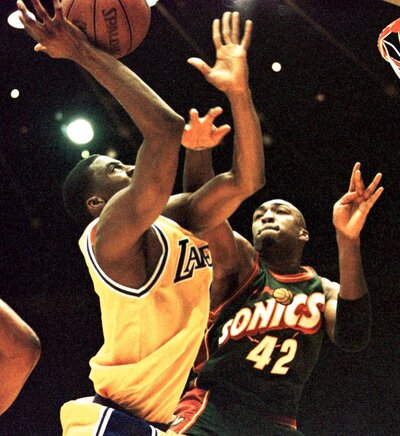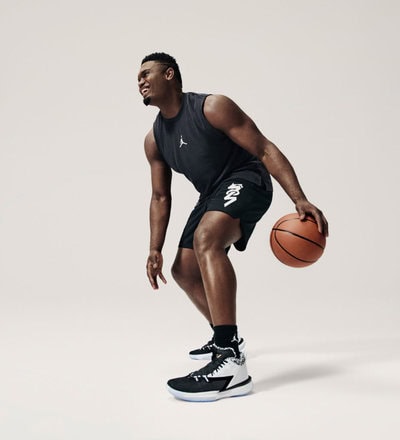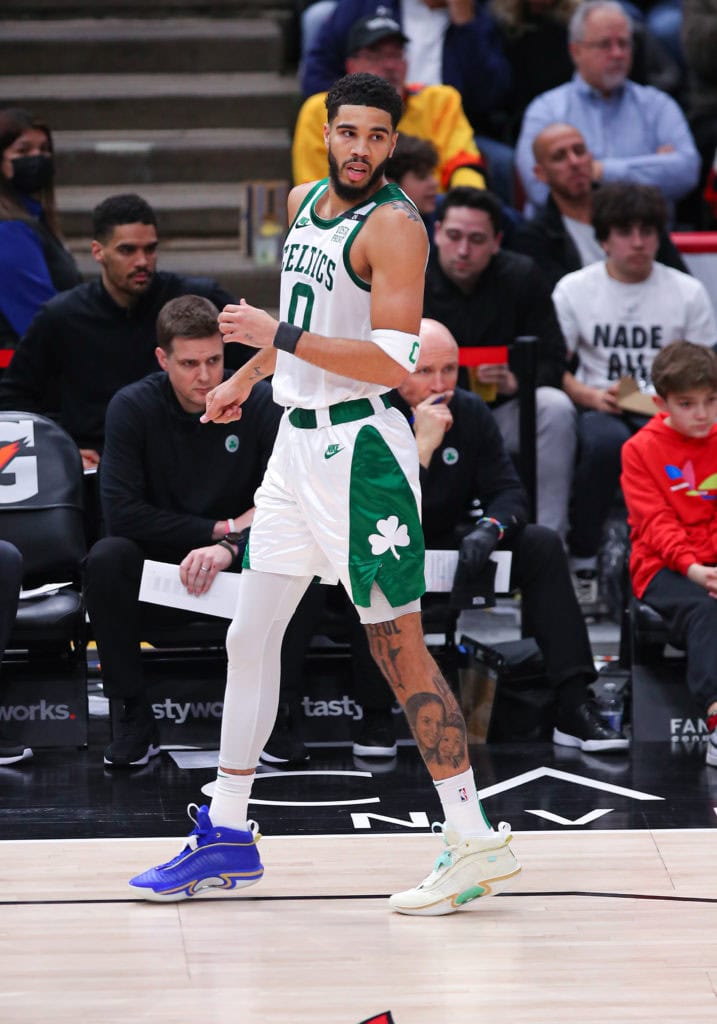With the Jordan Luka 1 hitting the floor for the first time, get the story behind every Jumpman athlete in the NBA to sign a namesake signature sneaker deal.
Brooms, buckets, and alley-oops were supposed to own weekend two of the 2022 NBA Playoffs.
Instead, Instagram and Twitter timelines were taken over by another news story: Dallas Mavericks standout Luka Dončić is not just back on the court, he’s playing in his all-new signature sneaker from Jordan Brand. Below-ankle in cut, above average in coverage, the marquee model debuted by Dončić carries a weight unmeasured in ounces, as it unites the game’s greatest player ever with the young star that many see as a future face of the league.
Not only does it bring together two generations, it pulls in audiences that exist in two hemispheres.
When considering the timing, it couldn’t be any better. This fall, Jordan Brand turns 25 years old.

In its quarter-century of existence, the likes of Ray Allen, Kawhi Leonard, and Maya Moore have carried on the legacy of Michael Jordan by wearing his namesake models while winning championships. While plenty of players have had team takes and retro renditions embossed with their initials in color schemes the world will never wear, only a handful of hoopers have actually had a Jordan Brand model released to the public with their own name officially attached directly to it.
Only six, to be exact.
Following the debut of the Jordan Luka 1, see the history of Jordan Brand signature basketball athletes below.
Eddie Jones & Vin Baker*
Year Signed: 1997
Signature Debut: Jumpman Pro Quick & Jumpman Pro Strong (1998)*
In the Fall of 1997, Nike announced Brand Jordan: a subsidiary within the Swoosh dedicated to His Airness. Truth be told, original Air Jordan creatives Rob Strasser and Peter Moore suggested that Mike jump from Nike in 1987 and start his own company. Remaining on brand in Beaverton, his loyalty paid off with pundits suggesting MJ now makes anywhere from $130 million to $150 million off his namesake clothing company, with annual revenues topping $4 Billion per year.

When Jordan Brand came to be in 1997, Mike and his associates assembled a team of disciples to carry on his legacy. The introductory class of hoopers all possessed the professional profile and dignified demeanor associated with Mike. At first, Team Jordan or Jumpman models were worn by the early endorsers, produced in volume while amplifying the design language of MJ’s signature shoes.
By season two, Jordan Brand toed the line of giving namesake silhouettes to their rising stars. The Jumpman Pro Quick and Jumpman Pro Strong came to life at the 1998 NBA All-Star Game in Madison Square Garden, making the most of the Mecca.
Los Angles Lakers wing Eddie Jones and Seattle Supersonics forward Vin Baker represented Jordan Brand’s range from big market to big man, painting the picture that Mike could move models associated to rival cities and opposing positions.
From 1998 through 2000, Jones donned the Pro Quick 1 and Pro Quick 2 before breaking out the Jumpman Swift 6 — a subtle nod to his jersey number, with design DNA pulled from the Air Jordan 15. At the same time, Baker broke out the Strong before having the aptly named Vindicate, suggesting his allegiance without straight-out saying it. All the while, both Baker and Jones rotated retro and team takes from Jordan Brand, proving a more fluid formula for the surging subsidiary.
Heading into the new millennium, Jordan Brand got younger by signing the likes of Mike Bibby, Quentin Richardson, and Darius Miles. All the while, they leveraged their youth to make Mike’s old shoes more modern rather than lacing them with signature shoes of their own.
In 2003, that would all change.
Carmelo Anthony
Year Signed: 2003
Signature Debut: Jordan Melo 1.5 (2004)
The 2003 NBA Draft was on par with that of 1984 and 1996, top-heavy in talent with plenty of players whose star power would endure late into their careers. But in the beginning, amid all the potential and all the question marks in the class, two names stood out as surefire sneaker stars: LeBron James and Carmelo Anthony.

As amateurs, Jordan Brand pursued both players. While LeBron James played at the Adidas-endorsed St. Vincent St. Mary’s in Akron, Mike’s company came through with packages for the young king that included player exclusive one-of-ones done up in green and gold. All the while, Carmelo played at the Jumpman-sponsored Oak Hill Academy, already indoctrinated in all things MJ.
When push came to shove, the company that wrote checks to Mike had more money to sign LeBron. While Nike landed 2003’s golden goose, Jordan still ponied up to pay Carmelo. Famously, they gave the Syracuse standout $3.5 Million per year for his first six years — the most Mike had ever paid another hooper to lead his label. This of course timed out with MJ’s final retirement, setting the stage for someone new to take the helm.
After a rookie season in Denver that included retro rarities and special shipments of the latest Air Jordan flagship models, Carmelo Anthony debuted a shoe to be called his own in the 2004 Olympic Games. The Jordan Melo 1.5 was a modernized hybrid of Mike’s first two models, led in palette and advertising by the arriving Nugget. For over a decade, we witnessed Jordan Brand signature shoes modeled after Melo, paving the lane for future stars to place their own name next to Mike’s.
Chris Paul
Year Signed: 2006
Signature Debut: Jordan CP3 (2008)

Michael Jordan knew who Chris Paul was before the world did. At summer basketball camps, the Winston-Salem native bossed around All-Stars and Hall of Famers as a high schooler with the same general demeanor he displays as an accomplished veteran.
Still, when entering the NBA Draft, it was Nike who swooped up the prodigal point guard. After winning Rookie of the Year in 2006, Jordan Brand jumped on the chance to steal Paul from the Swoosh. The move laid the foundation for other categories under the Nike, Inc. umbrella to swap endorsers within the greater family and brought up questions as to just how Mike could sign players to his sportswear subsidiary, while also courting them to come to his newly-owned Charlotte franchise.
After playing in PE pairs of retros, flagship signatures, and Jumpman models, the Jordan CP3 series came to life in 2008. Since arriving, the CP3 line has found an identity in low-top looks likened to the sharp play Paul has long possessed. In 2022, the signature series remains on the feet of Paul though lacks the retail imprint it once had.
Dwyane Wade
Year Signed: 2009
Signature Debut: Jordan Fly Wade (2011)
Pulling a page from Paul’s move from Nike, Chicago-born Dwyane Wade swapped sponsors in 2009 by breaking away from Converse and transferring to Jordan Brand. When Wade first joined Converse, he was a member of their rookie rebrand in basketball, joining the likes of Chris Bosh, Kirk Hinrich, and Mike Sweetney as a means to revitalize the Chevron in hoops.

Quickly, Wade arrived as more than just a rising talent but a true superstar, soon seeing his own signature shoes released by Converse. After initial intrigue and later fatigue, the Converse Wade line lost its step on the market, making room for its new parent company to reshuffle the deck. The same year Wade was drafted, Nike had acquired Converse for $309 million, owning the ability to influence the fate of both brands.
In 2009, Wade moved to Jordan Brand in a deal that shook up the industry. Shot alongside Michael Jordan with the Air Jordan 2010, the plan was to make the Chi City kid the face of the annual game shoe franchise he and all his peers pined for growing up. In 2010 and 2011, Wade wore the flagship Air Jordan model as a member of the red-hot Miami Heat, earning his own signature sneaker soon with the Fly Wade.
Paying homage to his business savvy North Star, Wade went rogue in the Fall of 2012 and left Jordan Brand for Chinese-based Li Ning. Earning equity and appealing to a massive market, the controversial decision allowed Flash the chance to pave his own path, just as Jordan did years before.
Russell Westbrook
Year Signed: 2013
Signature Debut: Jordan Why Not Zer0.1 (2018)*

Early endorsers at Jordan Brand leaned into Mike’s polished professional image on and off the court: class, smooth style, and fundamentally sound skills. In 2013, Jordan Brand brought on a man who matched Mike’s maniacal intensity: Russell Westbrook.
After ascending as a Nike athlete in Oklahoma City, the polarizing point guard brought a new level of brazenness and energy to a lineage that was feeling flat. With Westbrook, Jordan Brand had a SportsCenter mainstay while appealing to the game’s growing love affair with fashion.
Like Wade, Westbrook led flagship Air Jordan models for the early parts of his partnership. In a true zag, Jordan Brand introduced Russ to their retail realm with not just PEs made for the masses, but also his own lifestyle silhouette. By 2018, he had his own signature shoe made for performance with the Jordan Why Not Zer0.1. Since that time, his line has evolved to more models of his own likeness that push performance as well as his own One Take diffusion series that plays off the same Team Jumpman ethos Mike introduced in 1997.
Zion Williamson
Year Signed: 2019
Signature Debut: Jordan Zion 1 (2021)

For the first time since LeBron James, the sneaker industry had its hands full in an all-out bidding war. Who would sign Zion Williamson?
In a shocking surprise, the company was Jordan Brand. Not only did the typically frugal franchise bring on a Duke alum, they paid him a reported $75 million. It was the most they’d handed a rookie hooper since Melo and second in signing amount for a teenage baller only to King James.
After wearing the Air Jordan 34 for his first season and the Air Jordan 35 into his sophomore ascent, the Jordan Zion 1 debuted in 2021, not long after his first All-Star Game. While injury has kept the position-less Pelicans player off the court in 2022, practice shots have revealed a look at the upcoming Jordan Zion 2.
Luka Dončić
Year Signed: 2019
Signature Debut: Jordan Luka 1 (2022)
When Luka Dončić declared for the 2018 NBA Draft, some scouts saw how good he could be, but few marketers suggested he could sell shoes. While PUMA picked up numerous lottery signings and Adidas landed Trae Young, Luka actually had one more season left on his existing Nike endorsement deal he signed while playing in Europe.

Over the course of his Rookie of the Year-winning campaign, it quickly became clear that Luka was not just the guy in his draft, but ready to be a future face of the NBA. On the business side, the price went up, as Dončić’s deal with Nike was soon set to expire. Testing the market by playing in Under Armour Curry releases and competitor brands, it was ultimately Brand Jordan who signed the Slovenian superstar.
From then on out, Luka played in PE pairs of the Air Jordan 34 and Air Jordan 35 with his own low top looks and mid-top makeups making their way to retail. The Jordan Zoom Separate served as a bridge to the Jordan Luka 1, making the Maverick playmaker the sixth official Jordan Brand signature athlete in the basketball category.
Jayson Tatum
Year Signed: 2019
Signature Debut: Unknown (2022)
Like Eddie Jones, Chris Paul, and Russell Westbrook before him, Jayson Tatum started his NBA sneaker journey as a Nike athlete. Landing as a lottery pick in 2017 and ascending as the face of the Swoosh’s auto-lacing Adapt BB, Tatum’s star power had quickly risen, much like it did for Dončić.

In the summer of 2019, Jordan Brand brought on Tatum in what proved to be the start of a roster-wide makeover. Despite signing with Mike prior to both Zion and Luka, he’ll be the third player in that class to see his own signature shoe. While this playoff push sees Tatum taking his game to new heights in custom colorways of the Air Jordan 36, Boardroom’s Nick DePaula reports that his namesake model will hit the hardwood before the calendar year ends.